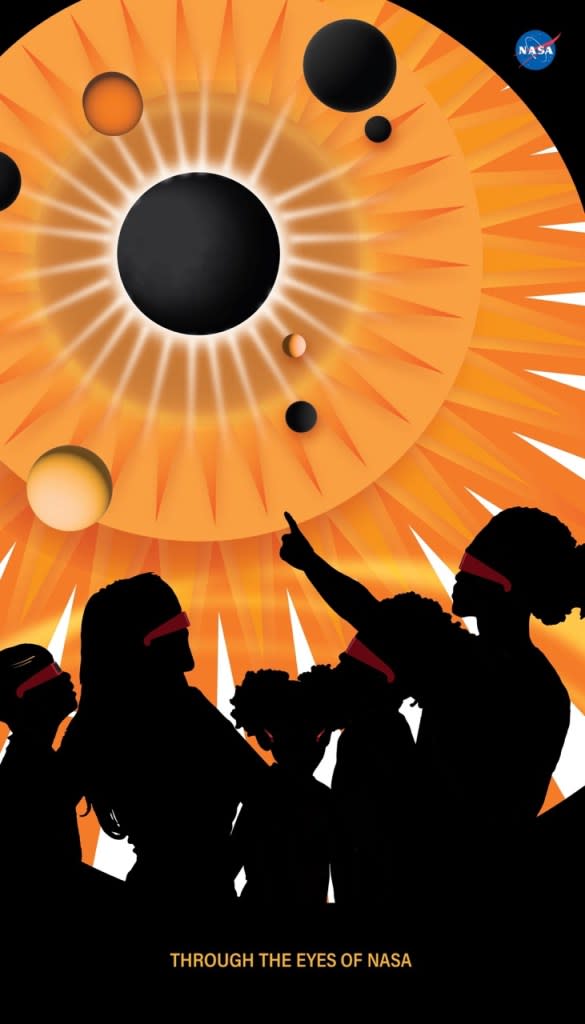Eclipse Fever Is Gripping Black Texans
The word “eclipse” comes from a Greek word meaning “abandonment,” but in Texas, this week’s total solar eclipse has had the polar opposite effect.
An estimated 4 million tourists are expected to have flocked to the Lone Star state to see the once-in-a-generation event, which starts in the Dallas area around 1:30 p.m. CT on Monday. Dozens of cities across Texas, including Dallas, will have some of the nation’s strongest views of the eclipse — the last to hit the U.S. until 2044.
Total eclipses normally unfold in secluded corners of the globe, but this time in addition to passing over Dallas — which is the largest city in the path of totality — major cities like Indianapolis and Cleveland will get full-on views.

It’s set to be a significant boon for the second-most populous state, which hasn’t had a total solar eclipse blanket its sky since July 1878 and isn’t expected to have another total eclipse until 2317. While visitors in Texas are expected to open their wallets to the tune of $1.4 billion, preparations for the event have disrupted life for many Black folks living in the state’s largest metro areas of Austin, Dallas, and Houston.
At least seven Texas counties have operated under emergency disaster declarations for weeks, as emergency management officials have told residents to stock up on several days’ worth of food, fuel, and water and to be wary of traveling away from their homes.
Officials are expecting hours-long traffic jams and strains on first responders and hospitals. There have also been fears around price gouging, which Texans have struggled through during various disaster declarations over the years. In addition to bringing up fears around the state’s oft-failing energy grid: A survey of 1,000 Texans found that over half of respondents are concerned about an eclipse-related power outage, with Dallas respondents leading the bunch at 58%.
Dallas-area resident Maurice Fulton says the hysteria makes sense in a state that has been caught slipping during several natural disasters over the past few years. But he can’t lie; it is a little annoying, and it shakes life for locals.
“Texas does have the tendency to create emergency situations where there shouldn’t be, only to cause a whole lot of panic,” Fulton said. “We had a situation like this a few years ago with gas, where they thought it was going to be a gas shortage, and everybody went, and literally created the shortage.”
The 35-year-old plans on watching the eclipse, having already blocked off some time for work when it is expected to hit the Dallas area around lunchtime, but for him, the spectacle is “just space doing what space does.”
At the same time, many people are excited to see the moon eat the sun for as long as four minutes in some parts of the state, including Dallas area resident Kelsey Thomas. A believer of astrology, she said she’ll be on the “lookout for any set rituals performed during” the eclipse and will be using the day to set intentions and journal. She was inspired by the communal aspect of watching the eclipse and seeing social media posts with tens of thousands of likes highlighting its significance.
Neil deGrasse Tyson will host an eclipse watch party in Dallas, as some have used the opportunity to highlight fields — astrophysics and astronomy — that have been mainly out of reach for Black folks. Just 3% of the workforce in these fields is Black.

What is a total solar eclipse?
A total solar eclipse is a rare natural phenomenon that occurs when the moon passes between the Earth and the Sun, casting a shadow on the Earth’s surface. With the bright disk of the Sun covered, the Sun’s outer atmosphere, known as the corona, becomes visible, appearing as a pearly halo surrounding the darkened moon. Right before totality, a phenomenon known as Baily’s beads begins, where beads of sunlight shine through the moon’s rugged terrain, creating a string of bright spots. The last bead of sunlight is often called the diamond ring because it makes the appearance of a glittering diamond ring in the sky.
Outside of the natural beauty of the event, it provides researchers with valuable insights into the workings of the solar system; NASA says it’s working on several research projects related to this total solar eclipse, including the impact of solar radiation on the Earth’s atmosphere.
Tips on viewing the eclipse if you’re located within its path
Except during the brief total phase of a total solar eclipse, when the Moon completely blocks the sun’s bright face, it is not safe to look directly at the sun without specialized eye protection known as “eclipse glasses” for solar viewing.
Viewing any part of the bright sun through a camera lens, binoculars, or a telescope without a special-purpose solar filter secured over the front of the optics will instantly cause severe eye injuries.
Remember to wear sunscreen, a hat, and protective clothing to prevent skin damage.
Plan ahead: Anticipate heavy traffic, crowded locations, and make sure to bring enough food and water in case you’re stuck in traffic for hours.
How to watch if you’re not in the eclipse’s path
You can watch the eclipse live on NASA’s website, no matter where you are in the world.
The post Eclipse Fever Is Gripping Black Texans appeared first on Capital B News.

